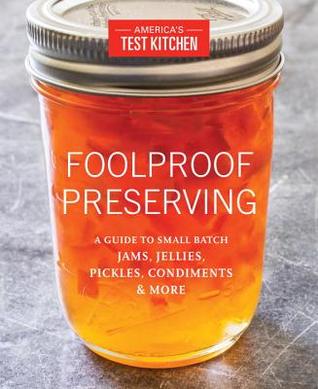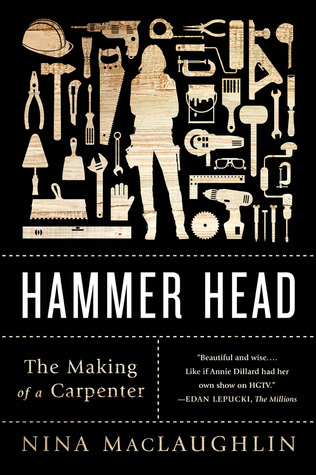After a decade of working as a newspaper journalist, Nina MacLaughlin is tired of sitting behind a computer screen - she wants to do something more physical. When she sees an ad on Craigslist looking for a carpenter's assistant and encouraging women to apply, she impulsively applies even though she has NO experience. She ends up getting the job and learning how to do all kinds of carpentry and other home renovation work. While the premise of the book sounded interesting, the actual story is kind of boring. She doesn't really talk much about her personal life or her relationship with Mary, the carpenter who hired her. I was also really curious about her money situation - she doesn't work for a few months in the winter and she never talks about how she plans for that, is she making more than at the newspaper?, etc. The last chapter is the best when she makes custom bookshelves for her Dad's new house and she can tell he's really impressed, but overall I didn't love it. Her writing style was kind of distant, almost like she's on the outside looking in.
Searching for Sunday: Loving, Leaving, and Finding the Church by Rachel Held Evans
This book is AMAZING! If you ever felt like you didn't fit in at church, this is the book for you! Evans grew up in an evangelical church and met her husband at a Christian college where her father was a professor. But, in college she started having doubts about some of the theology and cultural mindsets she was seeing both in college and in the church she attended. It wasn't until Tennessee was trying to pass Amendment One that defined marriage as only between one man and one woman that Evans mentally checked out of church and soon after quit attending regularly. When she started her blog where she wrote about a lot of the issues she was struggling with, she became the topic of lots of church gossip and ended up officially leaving her church. But, with her blog she connected with a whole host of like-minded people who felt run off by traditional churches. She also never lost her faith in God - just her faith in church. This book shares her personal story about church and some of the many stories of people she's encountered through her blog and speaking engagements. While you may not agree with every word she writes, the bigger picture of this book and Christianity as a whole is that there is so much more to God than what is represented in churches. Yes, the Church is supposed to represent God here on earth, but we often do a really terrible job with that. I can guarantee that you will ALWAYS be disappointed somehow, some time with church, but you will NEVER be disappointed with God.
Here are some quotes I really liked:
"Death and resurrection. It's the impossibility around which every other impossibility of the Christian faith orbits. Baptism declares that God is in the business of bringing dead things back to life, so if you want in on God's business, you better prepare to follow God to all the rock-bottom, scorched-earth, dead-on-arrival corners of this world - including those in your own heart - because that's where God works, that's where God gardens." (p. 21)
"Imagine if every church became a place where everyone is safe, but no one is comfortable. Imagine if every church became a place where we told one another the truth. We might just create sanctuary." (p. 73)
"It was a strange way to start a ministry - turning water into wine. And what sort of sign is it anyway, ensuring that a simple wedding feast carry on? It may be tempting to dismiss the miracle and Cana as a mere magic trick, an example of Jesus flexing his messianic muscles before getting to the real work of restoring sight to the blind and helping the paralyzed off their mats. But this is only because we have such a hard time believing that God cares about our routine realities, that God's glory resides in the stuff of everyday life, just waiting to be seen." (p. 155)
"Today, some of us struggle to see the Spirit within the religious institution, often for good reason. But God is present both inside and outside the traditional church, working all sorts of everyday miracles to inspire and challenge us if only we pay attention." (p. 197)
"As Brene Brown puts it, 'I went to church thinking it would be like an epidural, that it would take the pain away...But church isn't like an epidural; it's like a midwife...I thought faith would say, 'I'll take away the pain and discomfort, but what it ended up saying was, 'I'll sit with you in it.'" (p. 209)
"Marriage, like a meal of bread and wine, is just one more ordinary, everyday circumstance God transforms into an avenue through which to enter our lives. We must be careful, then, of idolizing the institution of marriage on the one hand and discounting its kingdom-reflecting potential on the other. What makes a marriage holy isn't the degree to which the two partners reflect gender stereotypes, or stick to a list of rule and roles, or even reflect cultural norms and expectations, but the degree to which the love of Christ is present in one of the most challenging and rewarding commitments two people will ever make to one another." (p. 243)

Bastards by Mary Anna King
Mary was the second of seven children born to her parents in Camden, New Jersey. She and her older brother Jacob watched as each of their sisters were adopted. Mary always vowed that someday she would find all her missing sisters. When she was 7 Mary and her brother Jacob went to live with their grandparents in Oklahoma who were already raising Rebecca, number 3 in the line of siblings. Things were VERY different in Oklahoma and after a few years Jacob was sent back to live with their father in New Jersey. When Mary was in college her sisters who had been adopted out started reaching out to their family to reconnect. While all the siblings wanted to reconnect, it was also traumatic to re-live all the chaos and trauma from their early lives. Despite LOTS of dysfunction, all the siblings establish a relationship with each other and their birth parents. King shows that family is often dysfunctional and messy, but there will always be a bond between siblings.

Infamy: the Shocking Story of the Japanese American Internment in World War II by Richard Reeves
When the Japanese bombed Pearl Harbor on December 7, 1941 President Franklin D. Roosevelt declared it "...a date that will live in infamy." Unfortunately, shortly after that surprise bombing the United States embarked on another infamous act - the internment of all Japanese-Americans for the duration of WWII. Most of those interned were American citizens, which undeniably went against the Constitution and their rights as citizens. Almost all of those interned lost everything - all their possessions, homes, land or businesses, and savings. Despite this, many of the young men interned were desperate to enlist in the military to prove that they were Americans and willing to fight for their country. Many Japanese-American soldiers died for their country and many more worked as interpreters and spies that greatly helped the US in WWII. While this book is fascinating, it was also a very hard read. To read of the wide-spread racism and hatred of political leaders, media, and average citizens was hard to stomach - including a racist cartoon drawn by none other than Dr. Seuss (p. 21)! Many people think of Hitler and the Jewish concentration camps when you think of WWII, but the US Japanese internment camps, while not designed to kill people, was almost equally horrific. I didn't realize until reading this book that the Civil Liberties Act of 1988 included a formal apology for the internment and gave each internment survivor $20,000. While, hard to read at times, this is a must-read simply so that more people are aware of this blight on US history and so we don't repeat the mistakes of our past again.
Some quotes I liked:
When the order for internment was issued, scavengers came out of the woodwork hoping to capitalize on the Japanese-American's misfortune. "As she was packing to leave...[she] was harassed by scavengers wanting to buy her best dishes, worth about $200. One by one, she took the dishes out of their velvet jackets and smashed them at the men's feet." (p. 59)
"A few white neighbors promised to look after homes and farms - some kept the promises, some did not. In Sacramento, a state agricultural inspector named Bob Fletcher agreed to take over the maintenance of three Japanese farms with ninety acres of vineyards. He paid the mortgages and taxes in exchange for 50 percent of the profits. When the war ended, the Nitto, Okamoto, and Tsukamoto families returned; their land and their profits waiting for them. The same kind of thing happened in Fresno, where a prosperous local farmer,...Hubert 'Dutch' Leonard,...agreed to manage a Japanese farm and turned over $20,000 in profits after the war. But such stories were rare." (p. 76)
"The government of Canada...relocated 23,000 persons of Japanese ancestry after declaring war on Japan. They were moved to camps and abandoned mining towns in the interior of the country; three-quarters of those interned were Canadian citizens...The evacuees' property was confiscated and auctioned off to help pay for the evacuation and internment." (p. 93)
"After the war, Major General Charles Willoughby, General MacArthur's chief of intelligence, said of the work of the [Japanese-American] linguists, 'Never before in history did an army know so much concerning its enemy prior to actual engagement, as the American army during the Pacific campaign. Those interpreters and translators saved over a million lives and two years.'" (p. 150-151)
"Edison Uno, a Nisei who was eighteen years old when he was released from detention after the war ended, devoted the rest of his life as a human rights activist trying to tell the story of the camps and organize Japanese Americans to demand government apologies and financial redress. Uno said of the silence, 'We were like the victims of rape. We felt shamed. We could not bear to speak of the assault.' That attitude began to change in the 1960s when Sansei, the third generation, many inspired by the black civil rights movement and growing anti-Vietnam War protests, began questioning their parents and grandparents about the camp years." (p. 273)
"One of the results of the new activism was the creation by Congress in 1980 of the Commission on Wartime Relocation and Internment of Civilians...Perhaps the most significant sentences of the report were: 'In sum, Executive Order 9066 was not justified by military necessity, and the decisions that followed from it - exclusion, detention, the ending of detention, and the ending of exclusion - were not founded on military considerations. The broad historical causes that shaped these decisions were race prejudice, war hysteria, and a failure of political leadership.'" (p. 276)

Flash: the Homeless Donkey Who Taught Me About Life, Faith, and Second Chances by Rachel Anne Ridge
Rachel Ridge was at the end of her rope. Her husband Tom had recently lost his job, so he joined Rachel in her mural business - it was a success until the 2009 economic downturn. They were struggling to find enough work to stay afloat with 2 teenagers and 1 daughter about to get married. One day after a long, hard day on a job that wasn't going to pay enough, Rachel and Tom come home to find a donkey in their driveway. They manage to get him into their pasture and figure they'll find his owner the next day - no one ever claims him and they end up keeping him and naming him Flash. While it didn't seem like the best idea to add another expense to their household, the whole family quickly falls in love with Flash. And soon Rachel is starting to realize that Flash is helping her see things in a new light - she is able to find new life lessons that help her take her own life in new directions. Flash becomes a catalyst for a happier life and a deeper faith. Each chapter ends with a life lesson that Flash helped Rachel realize. If you're an animal lover, this is a great story of how one lost donkey changed the Ridge family for the better.

A Good Place to Hide: How One French Village Saved Thousands of Lives During World War II by Peter Grose
The isolated village of Le Chambon in the Loire Valley of central France became a haven for Jews and other wanted people during World War II. Because the area was isolated and somewhat hard to get to, but also because there weren't large industries or natural resources there, it wasn't an early target of the Germans. A few people who were in the right place at the right time made history by refusing to bow to German occupation and laws that went against their personal and moral beliefs. Two pastors, André Trocmé and Édouard Theis, and a school headmaster, Roger Darcissac, were three community leaders who helped facilitate their community as a haven for Jews and other targeted people. There were also a few talented forgers who helped create fake paperwork to get people out of France and into safer areas. But, no one person could do what this community did together - virtually everyone in the community helped hide people, shared resources, and found ways to band together against the evil of Nazi Germany. The Loire Valley also became a hotbed of Resistance activity because it was isolated and not targeted for occupation by the Germans. This is a fascinating book that looks at how one community came together to help strangers. This was mostly accomplished because no one asked questions - they helped anyone who needed help. But, because no one actually asked if the people they were hiding were Jewish, the number helped is hard to nail down. Most accounts say between 2000-5000 people were hidden and/or given forged papers and roughly 3500 were most likely Jewish. My only (small) complaint about this book was that there was SO MUCH information and so many names to keep up with that it was sometimes hard to remember who was doing what - especially since many of the people were using fake names too. But, overall this was a great book about how people following their conscience made a difference and saved thousands of lives during one of the worst times in world history.
Some quotes I really liked:
André Trocmé and Édouard Theis issued a joint statement to their congregations that read in part, "The duty of Christians is to resist violence directed at our consciences with the weapons of the spirit. We appeal to all our brothers in Christ to refuse to agree with or cooperate in violence, especially in the coming days when that violence is directed against the English people. To love, to forgive, to show kindness to our enemies, that is our duty. But we must do our duty without conceding defeat, without servility, without cowardice. We will resist when our enemies demand that we act in ways that go against the teachings of the Gospel. We will resist without fear, without pride, and without hatred..." (p. 42) [The whole statement is at the end of the book and is definitely worth reading in its entirety]
"Magda Trocmé (pastor André's wife) went on the rounds of the hotels to ask some of the more prosperous Jews if they would contribute to the support of their co-religionists, particularly those from outside France. She was told: 'These foreigners that you bring to Le Chambon will be the ruin of us. We French Jews are not going to get mixed up with them.'" (p. 88)
On February 13, 1943 André Trocmé, Édouard Theis, and Roger Darcissac were arrested, but not charged with any offense and were transferred to Camp de Saint-Paul d'Eyjeaux, an internment camp for 'undesirables.' On March 15 the three men were told they needed to sign some paperwork and would be released. "When the three men read the paper to be signed, they found it contained a clause requiring them to swear allegiance to the government of Marshal Pétain [a puppet French government established by the Germans before total occupation] and to undertake to obey its orders. As school headmaster, Roger Darcissac had no choice. He was a public servant paid by the government; if he didn't sign, he would lose his job and be unable to support his family. So, he signed, and left on the five o'clock train. However, the two pastors refused...To the commandant's astonishment, they returned to their prison hut, where their fellow inmates couldn't believe what they were hearing...The next morning, he summoned the two men again. He had new orders. They could leave without signing the paper. They were free...A few days later, all the prisoners in the camp - about five hundred men - were packed onto trains and deported to Poland and Silesia. There is no record of any of them being heard from again." (p. 142-3)
"It would be nice to report that the world learned lessons from World War II, that the universal relief at the end of the fighting and the defeat of Nazism led the world to say 'never again,' and mean it. Yet among leaders all over the world today there are strutting buffoons who steal and cheat and lie and torture, and get away with it. The mighty still oppress the weak. There are millions of blameless people denied dignity, security and basic human rights in Syria, in Zimbabwe, in Palestine, in North Korea, in far too many countries and regions around the globe." (p. 278)

Unashamed by Lecrae
I wasn't familiar with Lecrae until a few years ago when my husband stumbled across his music. We both love music and unfortunately it can be hard to find really unique, creative Christian music artists. But, Lecrae most definitely is unique and creative. His memoir explores his rough childhood and youth - he grew up with a lot of abuse and violence. He became a Christian when he was in college, but it took awhile for him to really get serious about his faith. What I love the most about this book is how honest and raw he is - about how hard his childhood was and the things that he struggled with after becoming a Christian. I really love that he doesn't define himself as a "Christian rapper" - he is a rapper who happens to be a Christian so of course that will show up in his music, but he doesn't limit his music to "Christian" or "secular." Whether you're a fan of his music or not, he definitely has a story worth reading.
Some quotes I really liked:
"Being an outspoken Christian in the music industry means always feeling out of place. It's like whatever you have accomplished is less credible because of your faith. You're in the circle, but you're not really in the circle. You fit it, but you don't really fit in. When you're standing next to people or sitting beside people, it's as if you're not really there. This is one of the reasons I don't fully embrace the 'Christian rapper' label. It isn't that I'm ashamed of being a Christian. I'm not...But labeling the music that way creates hurdles and is loaded down with baggage. Plus, it just isn't a true expression of the music I'm making. I try to produce music that is life-giving and inspires people to hope, but it isn't just for the super-religious. I want to address themes that people who aren't Christians can appreciate." (p. 6-7)
"Or when we find culture alluring, but are uncomfortable with really engaging with it, we can copy culture. This is the approach that produces Christian films and Christian schools and Christian T-shirts and any other 'Christian' version of something - yes, that includes Christian music. None of these approaches are sufficient, [Andy] Crouch says. The only way to truly transform culture is to create culture." (p. 157)
"This has changed the way I do music. There is no such thing as Christian rap and secular rap. Only people can becomes Christians. Music can't accept Jesus into its heart. So I am not trying to make Christian music or secular music. I'm just making music. Hip-hop, like all music, is a good thing. I could use it for evil by filling it with violence and misogyny and profanity. Or I can use it to glorify God. Every song I write doesn't have to have the Gospel spelled out or quote Scripture so that people will know I love Jesus. My goal is just to use my gifts to produce great art that tells the truth about the world." (p. 193)

Evicted: Poverty and Profit in the American City by Matthew Desmond
This is a heart-breaking book about the effects of eviction on families living in poverty. Matthew Desmond follows a few people living in some of the poorest areas of Milwaukee, Wisconsin - some living in the "ghetto" on the North side of the city and some living in one of the worst trailer parks on the South side of Milwaukee. All of the people he follows made their fair share of poor choices, but overall they are struggling daily to try and make ends meet to support themselves and their families. For anyone living in poverty one unexpected emergency or lost job means the difference between making ends meet or possibly being evicted. Once evicted it's incredibly hard to get another lease and often housing in the poorest, most violent areas of town are not much, if any, cheaper than in nicer parts of town. "Public housing" is incredibly hard to come by and often evictions prevent someone from every qualifying for subsidized housing again. Desmond also found that having children makes someone even more likely to be evicted at some point.
I am a landlord, although it's not my full-time job, so I understand that landlords aren't running charities and when they don't get their rent, they still have to pay the mortgage on their rental property somehow. But, I could not in any way relate to the two landlords featured in this book. While I'm not targeting lower-income renters, they were just so heartless and had NO sympathy for their tenants - many of whom lived in appalling conditions. One of the landlords, Sherrena, had one of her buildings catch fire. In that fire one of her tenants had a child die - both tenants lost EVERYTHING they had, and her first question to the fire marshal was "Do I have to give them their rent back?" since the first was just after the first of the month - the answer was no. I just couldn't relate to them at all and I have no idea how they lived with themselves. Both Sherrena and Tobin (the trailer park owner) were slumlords in my opinion.
This was definitely an eye-opening book. While there is no easy answer to the issue of affordable housing for lower-income families, there have got to be better ways than what this book exposes.
Here are some quotes I really liked:
"Sherrena had bought a home in 1999, when prices were low. Riding the housing boom a few years later, she refinanced and pulled out $21,000 in equity. Six months later, she refinanced again, this time pulling $12,000. She used the cash to buy her first rental property: a two-unit duplex in the inner city, where housing was cheapest...Four years later, she owned thirty-six units, all in the inner city, and took to carrying a pair of cell phones with backup batteries, reading Forbes, renting office space, and accepting appointments from nine a.m. to nine p.m. Quentin [her husband] quit his job and started working as Sherrena's property manager and buying buildings of his own. Sherrena started a credit-repair business and an investment business. She purchased two fifteen-passenger vans and started Prisoner Connections LLC, which for $25 to $50 a seat transported girlfriends and mothers and children to visit their incarcerated loved ones upstate. Sherrena had found her calling: inner-city entrepreneur." (p. 12-13)
"Landlords were allowed to rent units with property code violations, and even units that did not meet 'basic habitability requirements,' as long as they were up front about the problems." (p. 73)
"Tenants able to pay their rent in full each month could take advantage of legal protections designed to keep their housing safe and decent. Not only could they summon a building inspector without fear of eviction, but they also had the right to withhold rent until certain repairs were made. But when tenants fell behind, these protections dissolved. Tenants in arrears were barred from withholding or escrowing rent; and they tempted eviction if they filed a report with a building inspector. It was not that low-income renters didn't know their rights. They just knew those rights would cost them." (p. 75)
"Some landlords neglected to screen tenants for the same reason payday lenders offered unsecured, high-interest loans to families with unpaid debt or lousy credit; for the same reason that the subprime industry gave mortgages to people who could not afford them; for the same reason Rent-a-Center allowed you to take home a new Hisense air conditioner or Klaussner 'Lazarus' reclining sofa without running a credit check. There was a business model at the bottom of every market." (p. 90)
"...Or the absentee landlord who failed to screen his tenants? Didn't he play a role in creating the drug house? The police and courts increasingly answer yes. It was in this context that the nuisance property ordinance was born, allowing police departments to penalize landlords for the behavior of their tenants. Most properties were designated 'nuisances' because an excessive number of 911 calls were made within a certain timeframe. In Milwaukee, the threshold was three or more calls within a thirty-day period...In the vast majority of cases (83 percent), landlords who received a nuisance citation for domestic violence responded by either evicting the tenants or by threatening to evict them for future police calls. Sometimes, this meant evicting a couple, but most of the time landlords evicted women abused by men who did not live with them...The year the police called Sherrena, Wisconsin saw more than one victim per week murdered by a current or former romantic partner or relative. After the numbers were released, Milwaukee's chief of police appeared on the local news and puzzled over the fact that many victims had never contacted the police for help. A nightly news reporter summed up the chief's views: 'He believes that if police were contacted more often, that victims would have the tools to prevent fatal situations from occurring in the future.' What the chief failed to realize, or failed to reveal, was that his department's own rules presented battered women with a devil's bargain: keep quiet and face abuse or call the police and face eviction." (p. 190-192)
"Residential stability begets a kind of psychological stability, which allows people to invest in their homes and social relationships. It begets school stability, which increases the chances that children will excel and graduate. And it begets community stability, which encourages neighbors to form strong bonds and take care of their block. But poor families enjoy little of that because they are evicted at such high rates." (p. 296)
"There are losers and winners. There are losers because their are winners. 'Every condition exists,' Martin Luther King, Jr. once wrote, 'simply because someone profits by its existence. This economic exploitation is crystallized in the slum.'" (p. 305)
"I am frequently asked how I 'handled' this research, by which people mean: How did seeing this level of poverty and suffering affect you, personally?...The honest answer is that the work was heartbreaking and left me depressed for years." (p. 328)
"There are costs to abandoning the first person. In the context of this study, it meant disguising when I intervened in nontrivial ways. There are two such instances in this book. When a 'friend' rented Arleen a U-Haul truck to move from Thirteenth Street and when Vanetta borrowed money from a 'friend' to buy a stove and refrigerator in anticipation of a visit from Child Protective Services, that was me...Scott still sends my eldest son a birthday card with a ten-dollar bill tucked inside, just like he did when he was homeless." (p. 335-6)












